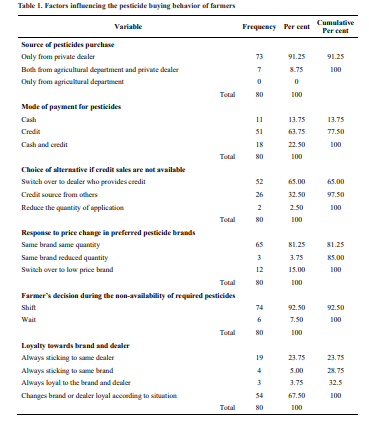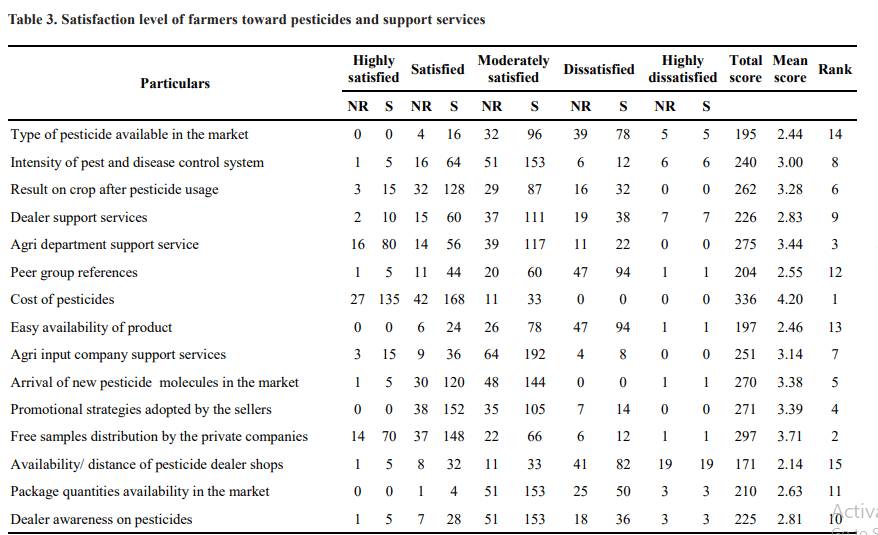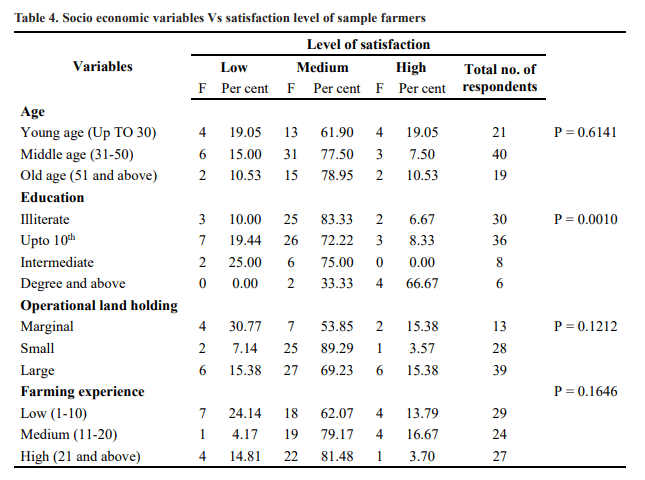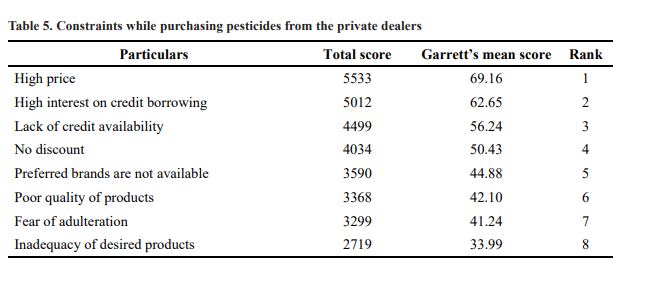Farmers’ Pesticide Buying Behaviour: Estimating the Influential Factors and Constraints in Kurnool District of Andhra Pradesh
0 Views
C. YASWANTH, N. VANI, B. APARNA AND B. RAMANA MURTHY
Institute of Agribusiness Management, S.V. Agricultural College, ANGRAU, Tirupati
ABSTRACT
The present study was to know the factors that influence the farmers buying behavior towards pesticides and constraints faced by them in Kurnool district of Andhra Pradesh. Kurnool district was purposively selected as it occupies first place in gross area sown in Andhra Pradesh. Among the crops cultivated in Kurnool district, cotton and chilli were selected as the pesticides consumption is high in these crops. The analytical tools employed were percentage and frequencies, Chi-square test, Garrett’s ranking technique and likert’s scale technique. Results reveal that credit availability, preferred brand and quality of the product were the factors that significantly influence the pesticide buying behavior of the farmers. Major constraints faced by the farmers while purchasing pesticides were high price and non availability of credit from private dealers and department of agriculture respectively.
KEY WORDS:
Buying behavior, chi-square, likert summative scale, pesticide and private dealers.
INTRODUCTION
Agriculture is primary source of livelihood up to 58 per cent of India’s population (Indian agriculture and allied industries report, 2018). With increasing population, demand for food and agricultural production is inevitable.
Pesticide consumption in India was accounted to 59,543metric tons, whereas in state of Andhra Pradesh it was accounted to 1432 metric tons (Indiastat, 2017-18). Pesticide usage increased rapidly for the last two decades at 12 per cent each year (Kumar et al., 2017).
Most of pesticide dealers do not have proper knowledge about the pest and diseases management but farmers take their advice over the pest and disease management due to availability to credit. In this context, the study is planned to understand the purchasing behavior of farmers towards pesticides in the Kurnool district of Andhra Pradesh.
METHODOLOGY
Kurnool district was purposively selected for the study, as it occupies first place in gross area sown in Andhra Pradesh. Out of the various crops cultivated in the Kurnool district two crops viz cotton and chilli were selected as the pesticides consumption is high in these crops. For each crop based on the highest area; two mandals were chosen. From each mandal, two villages were selected. Ten farmers from each village were
selected randomly, to make sample size to 80 farmers. The required data collected with the help of a pre-tested schedule for the year 2019-20 using survey method.
selected randomly, to make sample size to 80 farmers. The required data collected with the help of a pre-tested schedule for the year 2019-20 using survey method.
group of frequencies, chi-square test was employed as given TOOLS OF ANALYSIS
The data collected were subjected to appropriate set of statistical tools to arrive at valid conclusions. Data was statistically analysed using SPSS 19 version.
Frequencies and Percentages
Some of the data were also interpreted in terms of their frequencies and percentages wherever necessary to know the distribution pattern of respondents according to variables.
Chi-square test
To compare an observed with an expected in literature.
Garrett’s Ranking Technique
Garrett’s ranking technique was employed to prioritize or rank the level of information sources available on pest management, basis of application of chemical pesticides, factors influencing in the quantity of pesticides usage and brand selection, problems while purchasing pesticides from private dealers and agriculture department as given in literature.
Likert’s scale
Likert’s scale is named after its creator, Rensis Likert, who developed it in 1932. Likert’s scale is a psychometric scale used to scale the responses of the consumers. It was used to give quantitative value on subjective or objective dimensions, with various levels between agreement and disagreement. It is considered symmetric or balanced because there are equal numbers of positive and negative positions. Five point scale was given to the different parameters which are highly satisfied, satisfied, moderate, dissatisfied and highly dissatisfied to measure the pest management techniques adopted, services provided by pesticide private companies, agriculture department and support given by private dealers and peer group.
RESULTS AND DISCUSSION
Factors influencing the pesticide buying behaviour of farmers
Farmers bought pesticides from private dealers or from both private dealers and department of agriculture. A look through the Table 1 shows the percentages of variables with the sample farmers towards the buying behaviour of pesticides.
It reveals that greater percentage of farmers 91.25 per cent purchased pesticides from private dealers, 8.75 per cent of farmers from both agricultural department and private dealers and nobody relied on the department of agriculture exclusively as the department had limited pesticides at its dispersal. Farmers bought pesticides for cash, credit and for both cash and credit. Maximum farmers 63.75 per cent depended on credit purchases and minimum farmers 13.75 per cent bought through credit.
About 65 per cent preferred to switch over to the dealer who provided credit, 32.5 per cent opted to take credit from others and 2.5 per cent of farmers voted for reducing the quantity of pesticides application. It is therefore very clear that farmers switch over to dealers who provide credit. Pesticide prices keep changing from time to time and it is of interest to elicit farmers’ opinion on the pattern of use of pesticides, when prices change.
81.25 per cent preferred to use the same brand with same quantity, 3.75 per cent of farmers felt to use same brand with reduced quantity and 15 per cent of farmers switch over to low priced brand. Same brand same quantity was the opinion of greater percentage of farmers when prices change.
Information regarding farmer’s decision during the period of non-availability of required pesticides is presented in the table showed that in the absence of required brand, 92.5 per cent farmers shifted to other branded products while 7.5 per cent of farmers preferred to wait for their choice brand. The opinion of the farmers on the loyalty towards pesticide brands and private dealers was not uniform. Every farmer had his own opinion. Majority 67.5 per cent of farmers felt that they did not mind changing the brand or dealer according to the situation. There was nothing like commitment to a brand or dealer always. 23.75 per cent of the farmers were religiously sticking on to the same dealer without taking the situation into account. The practice of sticking on to the same dealer was found with 5 per cent of farmers and
3.75 per cent of farmers always loyal to the same brand and dealer. The results are in line with Dharmaraj and Desai (2013).
Factors influencing quantity of pesticides application and brand selection
Information regarding various factors influencing quantity of pesticides application and brand selection was analysed with the help of Garrett’s ranking technique and the same is presented in Table 2. Dealer recommendation was the first ranked factor influencing pesticide application. Intensity of pest and diseases was the second ranked factor. Types of pest and peer group recommendation were the 3rd and 4th ranked factors. Stage of crop growth, size of land holding and department recommendation were the next factors to follow. The least ranked factor were the free samples offered by the private companies and trail.
Satisfaction level of farmers towards pesticides and support services
The relevant factors for the satisfaction level of the farmers were considered to measure the satisfaction level of farmers towards pesticides usage and support services and the opinion of the farmers was measured through a five point rating scale (Table 3).
According to the sample farmers, their satisfaction level was high with the cost pesticides as it secured a mean score of 4.2. The next was free samples distribution by the private companies. Agri department support service, promotional strategies adopted by the sellers, arrival of new pesticide molecules in the market etc., were the factors to follow. Least rank was given to the availability/distance of pesticide dealer shops.


Socio economic variables Vs satisfaction level of sample farmers
Three quartile points for cumulative scores of level of satisfaction particulars were calculated and categorized as low, medium and high level of satisfaction. Chi-square test was used to test the association between the variables and their level of satisfaction towards pesticides usage and support services viz., low, medium and high.
From the Table 4 the “p” value were more than 0.05 for age of farmers, land holding and farming experience indicating that these variables were independent of farmer’s satisfaction towards pesticides and support services. For the variable education, p value was less than
0.05. This infers that the education was dependent of farmer’s satisfaction towards pesticides and support services.
CONSTRAINTS FACED IN PURCHASING PROCESS OF PESTICIDES BY FARMERS
Constraints while purchasing pesticides from the private dealers
The major constraint faced by the sample farmers while purchasing pesticides from the private dealer was high price of pesticides followed by high interest on credit as most of the farmers in the study area were purchasing pesticides on credit basis and dealers making it as an advantage they imposing high price for the borrowed (Table 5). The other constraints were in the order of lack of credit availability, discount during bulk purchases which was not forth coming, non-availability of preferred brands, poor quality of the products, fear of adulteration and inadequacy of the desired product. Lokesh et al. (2017) identified various constraints faced by the farmers with respect to pesticides were in line with the present study.
Constraints while purchasing pesticides from agriculture department
A perusal of Table 6 reveals that major constraint faced by the sample farmers while purchasing pesticides from the department of agriculture was no credit availability followed by untimely supply. When the timely availability was a constraint, probably farmers could do little on this and there is no way such a situation encourages the farmers to develop faith on the department of agriculture. It was also noted that farmers face constraints like non availability of preferred brands followed by poor quality of products, inadequacy of




desirable products, no discount on the pesticides, fear of adulteration and high price.
CONCLUSION
1.Majority of the pesticides purchases were from private dealers on credit basis and shift over to dealer who provide credit and stick to the same brand and same quantity.
2.Credit availability, preferred brand and quality of the products were the factors that significantly influenced the dealer’s loyalty.
3.Dealer recommendation and intensity of pest and diseases were the major factors that influenced the quantity of the pesticide usages.
4.Farmers’ satisfaction was ranked first with cost of pesticide and free samples distribution by the private companies but they are dissatisfied against agricultural department support services.
5.The most important problems faced by the farmers in purchasing pesticide from private dealer were high price and high interest on credit borrowing.
6.The major problems in purchasing pesticide from agricultural department were no credit availability, untimely supply and non-availability of preferred brands.
LITERATUCE CITED
Dharmaraj, S and Desai, P. 2013. consumer buying behaviour towards agricultural inputs: A study in area of Bardoli. Global Journal for Research Analysis. 2(6): 117-118.
Kumar, B.A., Ragini, K., Padmasri, A., Rao, K.J and Shashibhushan, V. 2017.Survey on pesticide usage pattern in bhendi (Abelmoschus esculentus L.). Bulletin of Environment, Pharmacology and Life Sciences. 6(1): 182-188.
Lokesh Babu, S., Suradkar, D.D and Dhage, S.V. 2017. Identification of constraints faced by farmers with respect to pesticides and suggestions to overcome constraints. Journal of Pharmacognosy and Phytochemistry. Spl. 1068-1070.
http://www.indiastat.com/agriculture-consumption of pesticides/2017-2018.
http://www.ibef.org/agriculture and allied industries/ 2018.
- Bio-Formulations for Plant Growth-Promoting Streptomyces SP.
- Brand Preference of Farmers for Maize Seed
- Issues That Consumer Experience Towards Online Food Delivery (Ofd) Services in Tirupati City
- Influence of High Density Planting on Yield Parameters of Super Early and Mid Early Varieties of Redgram (Cajanus Cajan (L.) Millsp.)
- Influence of Iron, Zinc and Supplemental N P K on Yield and Yield Attributes of Dry Direct Sown Rice
- Effect of Soil and Foliar Application of Nutrients on the Performance of Bold Seeded Groundnut (Arachis Hypogaea L.)

